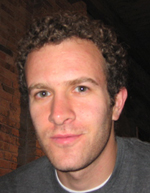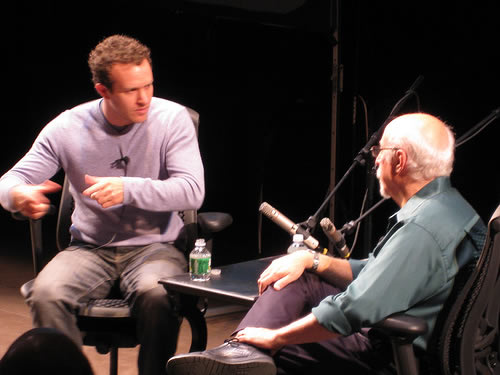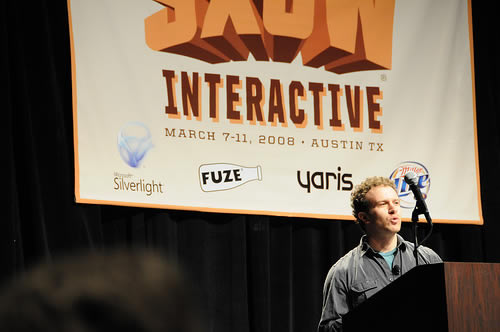
Jason Fried from 37signals joins me for this interview. 37signals builds Web-based software and service products for small businesses. They’re pretty famous in the web2.0 crowd for being easy to use. They are a relatively tiny company – typical of today’s best startups, with a small team who are all high-caliber guys. Jason talks about how the company is able to meet deadlines and deliverables even though all 10 employees work remotely. They even have an e-book on how they work online. He also talks about the one investor 37signals has, Jeff Bezos from Amazon.com. I asked Jason quite a lot about their remote working methodology, and I came away pretty impressed.
Full Interview Audio and Transcript
Personal Info
Hobbies and Interests: Drums, Architecture, Gardening.
Favourite Sports Teams: Not a sports fan.
Favourite Books:
- Maverick: The Success Story Behind the World’s Most Unusual Workplace by Ricardo Semler
- The Seven-Day Weekend: Changing the Way Work Works by Ricardo Semler
- The Innovator’s Solution: Creating and Sustaining Successful Growth by Clayton M. Christensen and Michael E. Raynor
Favourite Entrepreneurs: James Dyson, Ricardo Sembler, Jeff Bezos, Steve Jobs.
Company Website: http://www.37signals.com
Fast Track Interview
Adrian Bye: Jason Fried from 37signals is with me today. 37signals is a Web 1.0 company. Jason, tell us a little bit about who you are and what you do at 37signals.
Jason Fried: I am 33 and live in Chicago, Illinois. After I graduated with a degree in Finance from the University of Arizona, I realized I didn’t want to work in a bank or the stock exchange. Instead, I started my own business. I’ve always been interested in design and was doing freelance Web site design during and after college.
After college, I moved to San Diego to work as a creative director in a small Web design company. After three or four months, I realized I wasn’t built to work for other people. I decided to move back to Chicago and start my own company. Around 1999, I met a couple of other guys, and we started 37signals. For the next four years, we focused on Web design.
Around 2003, we were really busy and needed a tool to better manage our client projects.
![]() We looked at tools that already existed. We didn’t like any of them because they were too hard and didn’t solve the problems. Instead, we decided to build our own tool, which became Basecamp. We started using it internally with clients. Clients then said, “I need something just like this for my own business.”
We looked at tools that already existed. We didn’t like any of them because they were too hard and didn’t solve the problems. Instead, we decided to build our own tool, which became Basecamp. We started using it internally with clients. Clients then said, “I need something just like this for my own business.”
We decided we could turn this into a product other people could use. In February 2004, we launched Basecamp as our first product. Within a year, we decided to focus exclusively on building software.
Currently, we build Web-based software and service products. We have seven different products.
Our products are based around the idea of collaboration for small businesses.
Adrian Bye: Who runs the company and how does your company work?
Jason Fried: I am the majority owner. I have one partner, David Heinemeier Hansson. He invented Ruby on Rails, which is a very popular Web application framework that developers around the world are using.
Since 2004, we’ve actually been pitched by close to 30 different VC firms. We just didn’t want to take VC money because we were already profitable. In 2006, we took on one investor, Jeff Bezos, CEO of Amazon.com. We worked out a deal where he came on as a minority owner, and he’s available to us for advice when we need it. We also have access to the people around him who are incredibly talented and skilled.
Adrian Bye:How does your team work? How do you find guys?
Jason Fried: In the past three years, we have doubled in size to 10 people. We have five people in Chicago and five people in cities around the United States and Canada.
The five people who live in Chicago almost never see each other. Anyone’s free to go to our office if they wish, but most of us work from home on our own hours. We also don’t work on Fridays.
Out of the 10 people, we have six programmers, a couple of designers, a customer-service person, a writer, and some people who move between the two roles of designer and programmer. A lot of our people have multiple skills. For example, the guy who does a lot of our writing is also a designer. I design and oversee business development.
A great way to find programmers is to look to the open-source world because you can see what people have been doing for years and review code and documentation. You can see how people have worked remotely with others. If people can get things done in the open-source world, they can certainly get things done with our small team. Lastly, people who work in open-source love the craft of programming because they do it for free and on their own free time.
As far as designers, we look for people who have designed things on their own and come at design from a different point of view. We’re mostly interested in people who design things for real people and not for their peers, which often happens in art school. We care about people who understand what others need in order to get things done. Those are the kind of designers we like to hire.
We’re much more about building things small-business owners can use and understand quickly. It’s not about bells and whistles. It’s about actually getting things done. We’ve found that the people we like to hire are interested in that as well.
We’re also trying to hire people who don’t need to be managed and can take care of themselves. Since most of our workers are remote, they need to be self-motivated and organized. They need to be able to do things on their own without asking us a lot of questions.
We also don’t care where you went to school or even if you went to school. About half of the people at 37signals never graduated from college, and that’s entirely fine with us. It’s more about the work you get done, not where you went to school and what your homework was.
Adrian Bye: I’m skeptical about distributive work in a commercial environment. I know one guy who’s running a team of 80 people all around the United States, and it is working for him. My feeling is he could be five times more productive if he had everybody in one place. What are your thoughts on that?
 Jason Fried: I disagree with that fundamentally. The closer people are physically, the more opportunity there is to interrupt one another. Interruption is the biggest enemy of productivity. There is nothing worse for getting things done than having someone call your name from across the room, having someone tap you on the shoulder, or having someone pull you into a meeting. All it does is fragment your day into smaller chunks. Before you know it, you might have 45 minutes free per day to get something done. For example, you might have a 15-minute block and then a one-hour meeting. Then, you have a 60-minute block, and you have another hour meeting. Then, you have a 15-minute block if someone bothered you. You just can’t get things done that way. If you ask people when they’re most productive, they’ll tell you either early in the morning or late at night because no one’s around.
Jason Fried: I disagree with that fundamentally. The closer people are physically, the more opportunity there is to interrupt one another. Interruption is the biggest enemy of productivity. There is nothing worse for getting things done than having someone call your name from across the room, having someone tap you on the shoulder, or having someone pull you into a meeting. All it does is fragment your day into smaller chunks. Before you know it, you might have 45 minutes free per day to get something done. For example, you might have a 15-minute block and then a one-hour meeting. Then, you have a 60-minute block, and you have another hour meeting. Then, you have a 15-minute block if someone bothered you. You just can’t get things done that way. If you ask people when they’re most productive, they’ll tell you either early in the morning or late at night because no one’s around.
When you keep people apart, you give people uninterrupted stretches of time. Someone might be able to work on something for three hours straight. You can almost never do that in a traditional environment where someone’s always there to knock on your door or pull you into a meeting.
Adrian Bye: How do you know your guys are getting things done?
Jason Fried: You know things are getting done by looking at the products. We do things that take a week not three, six, or nine months. There’s no hiding behind the three-month deadline. If you haven’t committed anything this week, then we know things aren’t getting done. We also use Basecamp and other products to communicate and find out what’s happening. Short timeframes, small deliverables, and small decisions help people get things done and help everyone know that things are getting done.
Adrian Bye: One of your products, Campfire, is like an Instant Messenger. How does it work?
Jason Fried: Campfire is a real-time group chat. We use it as our virtual office. For example, anyone at 37signals can log in and ask anyone else a question. You can collaborate on things. It’s also passive. If I don’t want to pay attention to it, I can hide it. I can put it away and come back to it a few hours later.
Campfire also keeps a transcript of everything that was said. You can scroll back to see conversations you’ve missed. It’s persistent so you can log in at any time and jump back in time. You can share files, real-time images, and real-time code as well as chat in real time.
Adrian Bye: How does your Basecamp product work?
Jason Fried: Basecamp is a project-collaboration tool. We found that most project management tools were focusing on the wrong thing. They were focusing on the management part of it, not the collaboration part of it. They were focusing on control and not communication. They were focusing on one-way broadcasting of a project plan, not two-way, back and forth collaboration in communication.
The core of Basecamp is simple scheduling, simple to-do list, simple message board, and simple file-sharing. It’s not tailored to one industry or technology. It’s just simple things that every project requires to get things done. It’s used by industries, such as design, publishing, teaching, manufacturers, and professional services like lawyers and accountants.
Every product we build, we build for ourselves first. Then we turn it into a product for other people. We’ll say, “We’re not special or unique. We’re a small company. Millions of small companies are just like us. If we need it and have these problems, it’s probably pretty likely that other people need it and have these problems.”
For example, Highrise is our latest product. It is a simple contact manager and CRM customer-relationship management tool. We needed a way to keep track of conversations with the press and potential partners. Who talked to whom? What was said? What did they say? What needs to happen next? Where’s the contract for that one person?
We were keeping track of these conversations either not at all, on posted notes, on pieces of paper, or in our e-mail drafts folder. If David needed to talk to somebody I talked to last week, there was no way for him to know what conversation I had with this person. Nothing was centralized. That’s why we built Highrise. Now, it is used by business people to keep track of conversations they have with vendors, leads, employees, and suppliers.
Adrian Bye: How do you prioritize needs? Do you scratch your itches first? Do you look at what your customers are screaming about the most?
 Jason Fried: Initially, we scratch our own itch because we build the products for ourselves. Once people are using them, we receive feedback on what people want. It comes in the form of e-mails and a message forum. We also do surveys occasionally.
Jason Fried: Initially, we scratch our own itch because we build the products for ourselves. Once people are using them, we receive feedback on what people want. It comes in the form of e-mails and a message forum. We also do surveys occasionally.
We are paying attention to what they want, what we want, and what’s in the right spirit of the product. We have to be careful about what we add to our product. Even if a lot of people want something, it may not make sense in the product or fit the spirit of the product. Just like editors have to trim down a writer’s copy, we have to trim down the feature requests to make sure they actually make sense. It’s a delicate balancing act between what people want, what we want, what the product wants, and what the product doesn’t want.
For example, we’re going to launch a feature that’s been probably one of the top requests in Basecamp for the past few years. It’s the ability to respond to the message via e-mail. Currently, you have to log in to Basecamp to post a comment on a message, but you’ll now be able to just e-mail the comment. That’s something that’s been requested for such a long time, but we wanted to think about how best to do it and the implications of it.
We take our time to make sure we do it right. We’re constantly improving our products one little piece at a time. Some of the improvements are very subtle, but we think that those are often really important improvements. Improving speed to make something 25 percent faster is a much more valuable feature than a brand-new feature. We can improve the copy on the instructional text. There’s a label of the field. Little tiny things like that make a big difference. We’re always looking at little things like that as well.
Adrian Bye:How do you acquire customers?
Jason Fried: We acquire almost of our customers by word-of-mouth. In four years, we have probably spent less than $25,000 on marketing and advertising. Our marketing is just sharing what we do and what we believe.
We wrote a book called Getting Real, which is about everything we do and how we do it. You can read it at gettingreal.37signals.com. We also blog about the things we do, the mistakes we’ve made, and the ideas we have.
This year we will probably look into more traditional sales channels and customer acquisition models to reach a whole new audience we won’t be able to reach just through word-of-mouth.
Adrian Bye: Have you heard of the e-mail service called iContact? Are you doing any cross-promotion with companies like that?
Jason Fried: We haven’t done anything like that yet. We’ve been focused pretty much in getting our products to the point they’re at now. This year and moving forward, we definitely want to look at a variety of different opportunities for us to get in front of people who don’t know about us.
We’re definitely interested in talking to people who have exposure to small businesses of 10 people, five people, or less. A lot of our customers actually are individual freelancers. The idea of the independent contractor, the freelancer, and the side-business person is so underserved. It’s the person who has a job from 9 to 5, comes home, and works three hours at night on their own little side project. That market is huge, and the software industry doesn’t go after them.
The other thing is that the people who buy our products are the same people who use our products. It’s not the same in the enterprise software world where you have a buyer who buys something and the users are completely different. There’s a really close connection between value, usability, solving problems, and affordability.
Adrian Bye: Have you thought about a particular revenue model? Do you have a payout for a customer acquired or a revenue share that you do for sales that are made for you?
Jason Fried: Yes, we do that on a custom-basis. We currently have an affiliate program that’s only for existing customers, but we’re going to expand that shortly.









